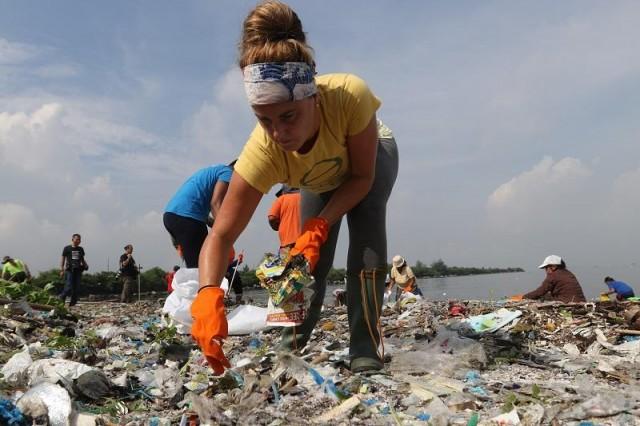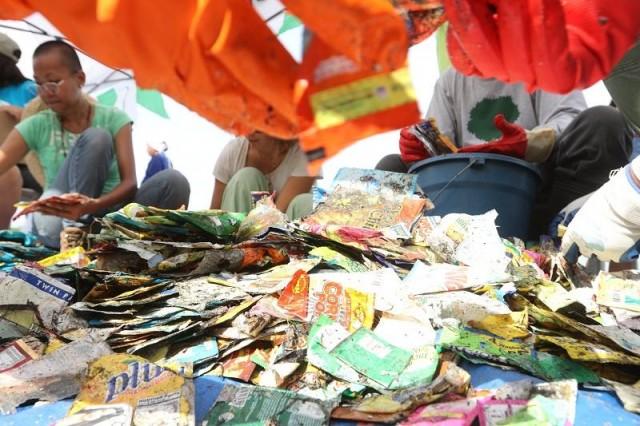7 things I realized after I joined a coastal cleanup
I joined Greenpeace’s recent coastal cleanup because while on vacation in Siquijor last June, I would spend a few hours every day picking up trash on the beach.
“Habagat po kasi,” one soft-spoken member of the hotel’s staff said, trying to explain it wasn’t their beach or Siquijor that was dirty.
And it’s true: The beach was very clean.
It’s just, something was always washing ashore: empty plastic bags of junk food, a broken piece of slipper, too many lighters, more empty bags of junk food, and the worst of them all, an empty container of gasoline.
So when the opportunity to participate in a coastal cleanup came up, I jumped at the chance. I woke up before 5 a.m., got to Freedom Island before 7 a.m., and was jolted out of my sleepiness with the warm and gentle colors of sunrise; if it weren’t for the ton of trash on the beach, any Manila resident would be grateful to have a slice of heaven nearby.

“Parang hindi nangyari yung weekend,” one of the Greenpeace folks said as we were driving up the main site. He was looking at the sea, which was choked up with so much trash. Over the weekend, he said, about 3,000 people gathered for the international coastal cleanup day. That crowd was able to fill sacks upon sacks with plastic from the ocean.
But today, there was more garbage to clean up.
With tongs in hand, I picked up trash from the shore. It may have been just two hours, but I learned so much about our consumption, dignity we can give ourselves, and what we can do.
1. I learned we are very, very tired. So tired that we will get convenience and effortless living where we can: easy coffee in the morning, sachet servings of cooking oil, laundry detergent, and lotion because carrying them in bulk is too much of a hassle for the climb up the MRT stairs, for chasing the bus, for hailing a taxi, for the walk home. We choose personal care products in sachets for when we travel, for a lighter load back home.
2. We need coffee. Perhaps this proves our fatigue: of all the pieces of plastic floating in Manila Bay, sachets of 3-in-1 coffee were the most I picked up. Extra creamy, extra strong, white, brown, barako — you name it, I’ve picked it. It doesn’t matter how it gets to us, or in what form, we need coffee, we want it, and the world has something to show for it.
3. Having instant noodles for lunch is never just having instant noodles for lunch. It comes with seasoning, sometimes two or three at a time, which means having instant noodles for lunch is times three in plastic waste. Yikes! I picked up more plastic bags of these add-ons than the actual instant noodles in Manila Bay.
4. We’re addicted to sugar and salt. Mother Earth offers an explanation on why we are fat: on the shore were too many candy wrappers floating alongside too much plastic, from everything inside a packet of instant noodles to junk food. We all know sugar contributes to excess weight, but salt, too, impacts our weight; it makes us bloated, to begin with. If you’re wondering why we’re still fat despite all the hard work and the complementary dieting we do, here are our answers.

5. There are things better consumed in bulk. Let’s not delude ourselves: We pick up small packets of peanuts and green peas with the best intention of limiting our calorie intake and our spend. But let’s be honest: Do we really stop at one packet of peanuts? If you can honestly say yes, good on you and please tell us how you do it. If not, get a bigger bag of your favorite chichirya. It will save you the hassle of opening yet another bag, it’s cheaper in the long run, and it will save our seas, too.
6. You can tell which advertising efforts are truly successful. I highly suggest advertising and brand executives to join coastal cleanups—or, better yet, to initiate one. Here, they’ll get no-BS insight and evidence for their efforts.
I was picking garbage alongside college students who would sing the commercial jingles of the brands they happen to pick up — mint gum and candies, most of them. They’d be reciting their taglines, or wowing on products and brands they are familiar with and have picked up yet again. On Freedom Island, which is where water from Manila Bay flows into, ad executives will be able to see which products actually move from grocery shelves into people’s homes, and subsequently, into our oceans.
7. We deserve better (coffee). We work hard, wake up early, conquer traffic, deal with our evil bosses, and pay taxes. It might feel extravagant, what with the time and all, but the least you can do for yourself is to get some proper coffee. Sure, 3-in-1 coffee might be the most convenient option, but those sachets are what’s clogging Manila Bay most. Besides, you can give yourself eight minutes to brew a proper cup, yes? Let yourself —and Mother Earth — breathe easy. — BM, GMA News



